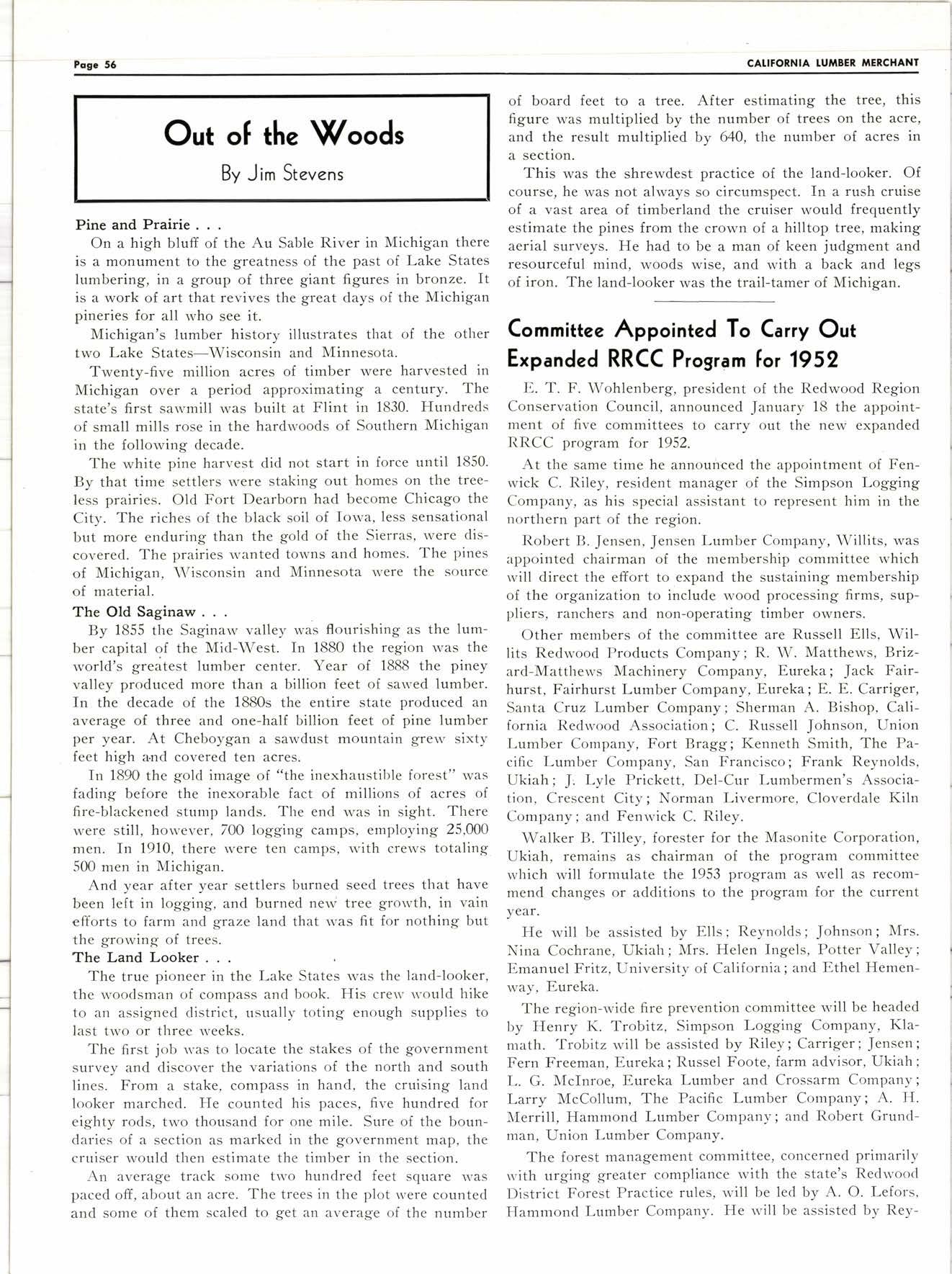
3 minute read
Out o[ the Woods
Bv Jim Stevens
of board feet to a tree. After estimating the tree, this figure was multiplied by the number of trees on the acre, and the result multiplied by 640, the number of acres in a section.
Pine and Prairie .
On a high bluff of the Au Sable River in Michigan there is a monument to the greatness of the past of Lake States lumbering, in a group of three giant figures in bronze. It is a work of art that revives the great days of the Michigan pineries for all 'ivho see it.
Michigan's lumber history illustrates that two Lake States-Wisconsin and Minnesota.
This was the shrewdest practice of the land-looker. Of course, he was not always so circumspect. In a rush cruise of a vast area of timberland the cruiser would frequently estimate the pines from the crown of a hilltop tree, making aerial surveys. He had to be a man of keen judgment and resourceful mind, woods wise, and with a back and legs of iron. The land-looker was the trail-tamer of Michigan.
of the other Committee Appointed To Carry Out
Twenty-five million acres of timber were harvested in Michigan over a period approximating a century' The state's first san'mill was built at Flint in 1830. Hundreds of small mills rose in the hardr,voods of Southern Michigan in the following decade.
The white pine harvest did not start in force until 1850. By that time settlers were staking out homes on the treeless prairies. Old Fort Dearborn had become Chicago the City. The riches of the black soil of Ior,va, less sensational but more enduring than the gold of the Sierras, rvere discovered. The prairies 'ivanted towns and homes. The pines of Michigan, \\Iisconsin and Minnesota I'vere the sotlrce of material.
The Old Saginaw. .
By 1855 tl-re Saginaw valley w'as flourishing as the lumber capital of the Mid-West. In 1880 the region was the world's greatest lumber center. Year of 1888 the piney valley produced more than a billion feet of sarved lumber. In the decade of the 188Os the entire state produced an average of three and one-half billion feet of pine lumber per year. At Cheboygan a sawdust mountain grerv sixty feet high a.nd covered ten acres.
In 1890 the gold image of "the inexhaustible forest" 'ivas fading before the inexorable fact of millions of acres of fire-blackened stump lands. The end 'i'i'as in sight. There u'ere still, horvever, 7@ logging camps, employing 25,000 men. In 1910, there rvere ten camps, with crervs totaling 500 men in Michigan.
And year after year settlers burned seed trees that have been left in logging, and burned new tree grorvth, in vain efforts to farm and graze land that was fit for nothing but the growing of trees.
The Land Looker
The true pioneer in the Lake States was the land-looker, the woodsman of compass and book. His creu'u'ould hike to an assigned district, nsually toting enough supplies to last t'il'o or three t'eeks.
The first job rvas to locate the stakes of the government survey and discover the variations of the north and south lines. From a stake, compass in hand, the cruising land looker marched. He counted his paces, five hundred for eighty rods, two thousand for one mile. Sure of the boundaries of a section as marked in the g'overnment map, the cruiser would then estimate the timber in the se,ction.
An average track some tn'o hundred feet square rvas paced off, about an acre. The trees in the piot rvere counted and some of them scaled to get an average of the number
Expanded RRCC Prosram lor 1952
E. T. F. Wohlenberg, president of the Redwood Regior-r Conservation Council, announced January 18 the appointment of five committees to carrv out the new expanded RRCC program for 1952.
At the same time he announced the appointment of Fenwick C. Riley, resident manager of the Simpson Logging Company, as his special assistant to represent him in the rrortlrern part of the region.
Robert B. Jensen, Jensen Lumber Company, Willits, was appointed chairman of the membership committee rvhich rvill direct the effort to expand the sustaining membership of the organization to include wood processing firms, suppliers, ranchers and non-operating timber owners.
Other members of the committee are Russell Ells, Willits Redwood Products Company; R. W. Matthe'ivs, Brizard-Matthervs Machinery Company, Eureka; Jack Fairhurst, Fairhurst Lumber Company, Eureka; E. E. Carriger, Santa Cruz Lumber Company; Sherman A. Bishop, California Redrvood Association; C. Russell Johnson, Union I-umber Company, Fort Bragg; Kenneth Smith, The Pacific Lumber Company, San Francisco; Frank Reynolds, Ukiah; J, Lyle Prickett, Del-Cur Lumbermen's Association, Crescent City; Norman Livermore, Cloverdale Kiln Company; and Fenwick C. Riley.
Walker B. Tilley, forester for the Masonite Corporation, Ukiah, remains as ,chairman of the program committee r,vhich will formulate the 1953 program as well as recommend changes or additions to tl-re program for the current yeaf.
He will be assisted by Ells ; Reynolds; Johnson; Mrs. Nina Cochrane, lJkiah; Mrs. Helen Ingels, Potter Valley; Emanuel Fritz, University of California; and E,thel Hemenrvay, Eureka.
The region-rvide fire prevention committee will be headed by Henry K. Trobitz, Simpson Logging Company, Klamath. ',lrobitz 'ivill be assisted by Riley; Carriger; Jensen ; Fern Freeman, Eureka; Russel Foote, farm advisor, Ukiah; 1,. G. Nfclnroe, Eureka Lumber and Crossarm Company; Larry McCollum, The Pacific Lumber Company; A. H. X{errill, Hammond Lumber Company; and Robert Grundman, Union Lumber Company.
The forest management committee, concerned primarily u'ith urging greater compliance rvith the state's Redu'otld District Forest Practice rules, will be led by A. O. Lefors, Hammond Lumber Company. He'rvill be assisted by Rey-










